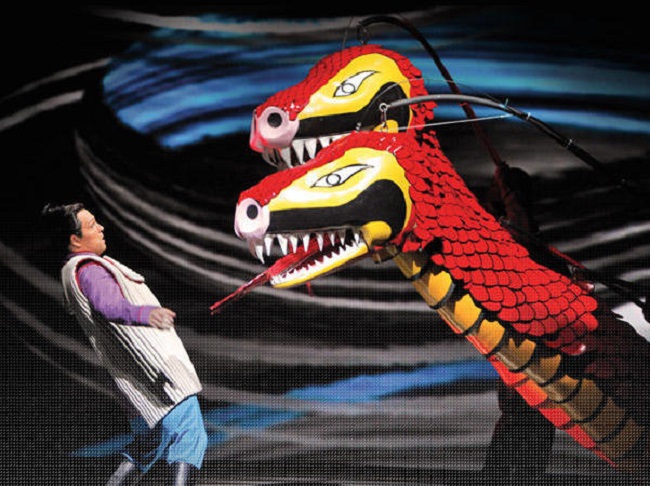Jun Kaneko, 71, doesn’t know much about opera, had never previously been to an opera and, although he spent the last ten years of his life designing costumes and sets for operas, still doesn’t consider himself a fan of the artform.
With this in mind, it’s all the more interesting how one of the world’s most famous living ceramic artists threw himself into productions of Madama Butterfly (2006), Fidelio (2008) and, most recently The Magic Flute, which wrapped up at the Kennedy Center this month. Kaneko recently announced that Butterfly, his first work in the opera world, was picked up for another showing at the San Francisco Opera for June 15, 18, 21, 24, 27 and July 3, 6, and 9.
Anne Midgette of the Washington Post interviewed Kaneko on his work for Flute, which was a co-production between the San Francisco Opera, Opera Omaha and the Washington National Opera.
Kaneko moved to the United States from Japan in 1963. He studied at the Chouinard Institute of Art and studied with Peter Voulkos, Paul Soldner and Jerry Rothman in California during what was to be recognized as the contemporary ceramics movement. Today, Kaneko’s work is included in the collections of more than 70 museums and he’s received more than 30 public art commissions in the United states.
He took on opera because he wanted a challenge, he told The Washington Post. His work with Butterfly took him 3 1/2 years, working ten hours a day. He said he applied the design principles he honed in the studio to the stage.
“Basically, everything that happens within the stage opening and on the stage is a visual statement that the designer can control. That involves movement, lighting and obviously design. The problem is, it keeps on changing. A singer moves from the center of the stage to stage left a little bit, [and] it completely changes. The lighting designer changes a little bit, everything changes. To make it [work] every second is the amazing concentration and challenge of it.”
When he was prepping for Flute Kaneko said he listened to the opera several times a day, trying to empty his mind and create a visual style from the music he was hearing. During his prep stage, he avoided watching performances of the opera so his own visualizations wouldn’t be influenced by someone else’s. His overall goal was to create a flowing visual style that was unbroken by the performers or changes in scenes. By his third opera he felt comfortable enough to incorporate video-projection into the sets. Although Kaneko’s end-result was praised by critics with words like “stunningly visual, Kaneko talks as though he’s done with opera for now.
“The experience of designing in the opera really added an amazing design point of view in my visual art. Opera is definitely everything: sound, lights, space, just the whole natural world on the stage. If I’m doing a painting, a painting is a painting, a flat surface. I don’t worry about the back side of the canvas. So it’s a completely different thing. [The influence of opera on my studio art] will come out, but you might have to wait about 10 years to see it.”
Above image: Jun Kaneko’s work on The Magic Flute, which completed its run this month at the Kennedy Center.
Any thoughts about this post? Share yours in the comment box below.







Jun Kaneko’s set designs and costumes for The Magic Flute, which completed its run this month at the Kennedy Center.




Sets and costumes by Jun Kaneko for Opera Omaha’s production of Madama Butterfly in 2006. Since then, Jun’s take on the opera has been reproduced by the Dayton Opera, Hawaii Opera Theater, Atlanta Opera, Madison Opera and the Opera Company of Philadelphia. This was Jun’s first work in the medium.





Kaneko’s set and costume work for Beethoven’s Fidelio in 2008. The artist created sets which were large in scale, but minimal in construction. Grids frame the action throughout.
Read the interview with Kaneko in The Washington Post

Just saw the PBS documentary on him and his work. I was mesmerized. Love the Magic Flute sets and costumes.
beautiful !!!! congratulations Kaneko
I loved seeing Kaneko’s opera sets, was not aware he had branched out in this direction. Would be nice if he gets a chance to work with the Miami Opera!!